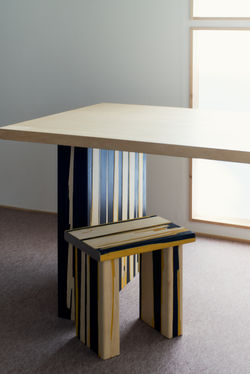 |
|---|
 |
 |
 |
 |
 |
 |
 |
PARI PARI
Hegi is a method of making wooden shingles that has been used in Japan since ancient times. It involves cutting logs into planks with a machete instead of a machine. Nowadays, it is common to use a woodworking machine such as a bandsaw or planer to flatten the surface of wood. Although Hegi is an analogue method of splitting wood with a machete, along the fibers to make boards, it allows the wood to be made into thin sheets that retain the uneven feel of the wooden surface. In addition, it prevents the wood from bending or warping, often caused by using machines. Currently this method is still used when making traditional wooden structures like roofs and shrine walls.
Inspired by the Japanese technique of Hegi and its ability to preserve the uneven feel of the wooden surface, I have applied it to modern technologies to search for a new form of expression in furniture design. PARI PARI is an onomatopoeic Japanese word that refers to the sound of a thin plate breaking, similar to ice. Thin sheets of coloured wood are laminated and glued together in layers, similar to plywood. The surface layers are then peeled off before the glue hardens, creating a random pattern resembling the bark of a tree. Normally plywood is manufactured in a calculated and precise manner using specialized machines. By incorporating irregular and uncontrollable hand-work into the process, you can create unique and natural patterns.
When we create something we usually move our hands with a vague idea of the finished product in our minds. By adding a process that cannot be controlled by the human hand, as if to betray our creativity. We can touch a part of the beauty that is sometimes brought about by chance, as in the natural landscape.
日本では古くから木材を製材する際に機械を使わず、鉈で丸太を板材に加工する”枌(へぎ)”と呼ばれる方法が使われてきました。今日では機械で木材の表面を均一に削り製材する方法が一般的ですが、木材を鉈で繊維方向に割いて板状に加工するこのアナログな方法は、木材表面の凹凸を残したまま木を薄く製材することが可能なため、機械加工と比べて製材後の木材の反りや曲がりが抑えられ、今でも神社の屋根や壁板といった伝統的な木造建築の建材に使われています。
このように、木材の自然な風合いを活かした加工法を近現代に発達した製造技術に応用することで、家具製作における新たな表現手法を探求しました。
PARI PARIとは、薄く張った氷のような薄い板状のものが割れる時の音を指す、日本特有の擬音語です。
着色した薄い木のシートを、合板を作るように何層も積層・接着し、接着剤が硬化する前に表層のレイヤーをパリパリと剥ぎ取ると、まるで樹木の表皮のようにランダムなパターンが生まれます。本来、特殊な機械により合理的かつ正確に製造される合板ですが、不規則でコントロールできない手加工を工程に組み込むことにより、一つとして同じものの生まれない自然な模様を作り出すことが可能になりました。
我々は普段何かを生み出す際に頭の中でぼんやりと完成の状態を思い浮かべながら手を動かしますが、その創造力を自ら裏切るかのように、あえて人の手ではコントロールすることのできないプロセスを加えることで、時に自然の風景に見られるような偶然がもたらす美の一端に触れることができるのではと考えます。


